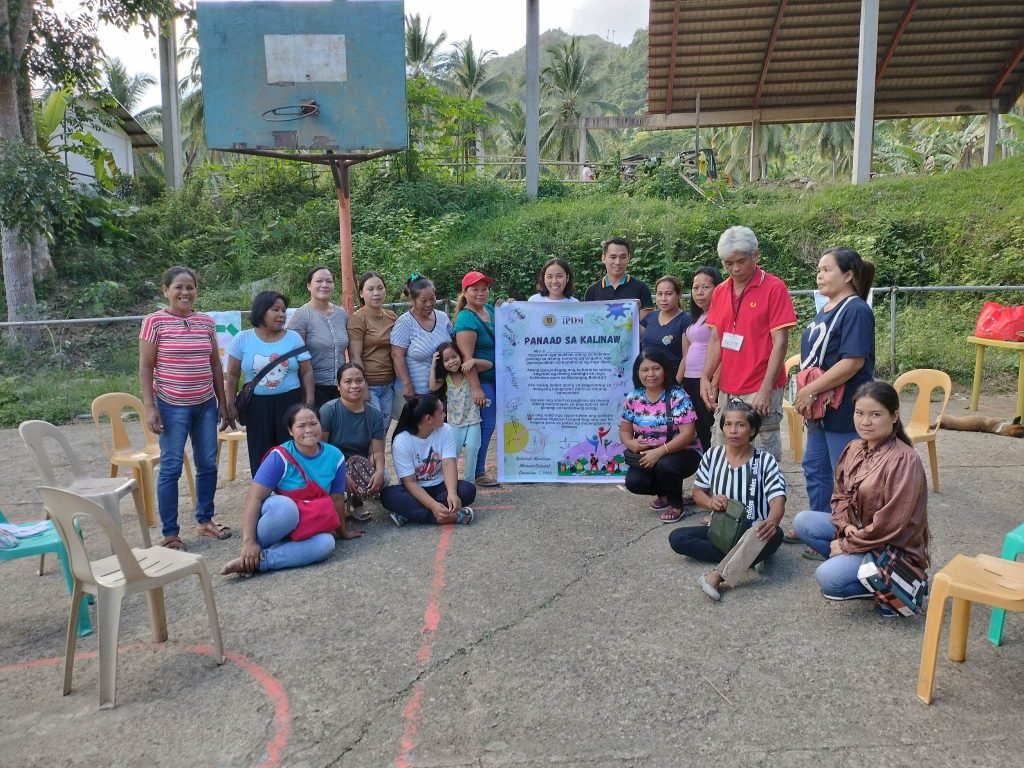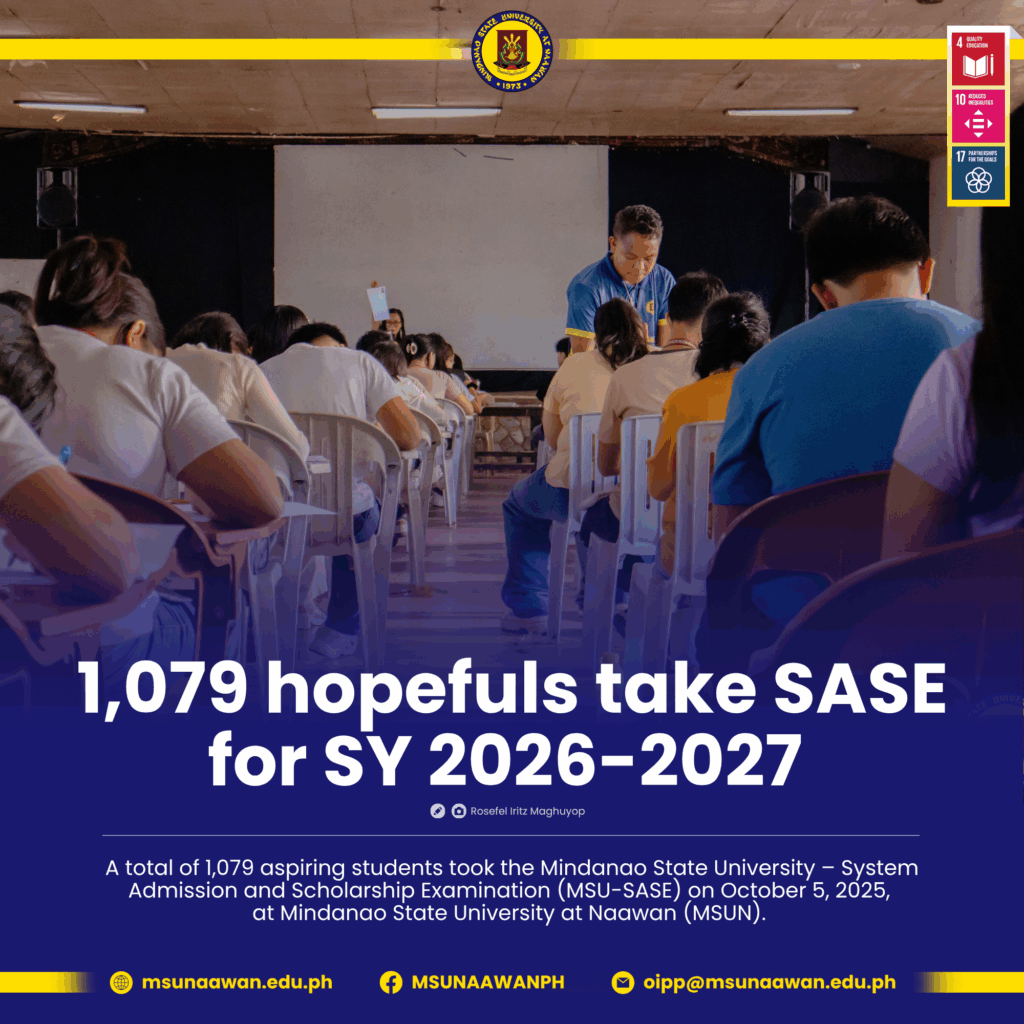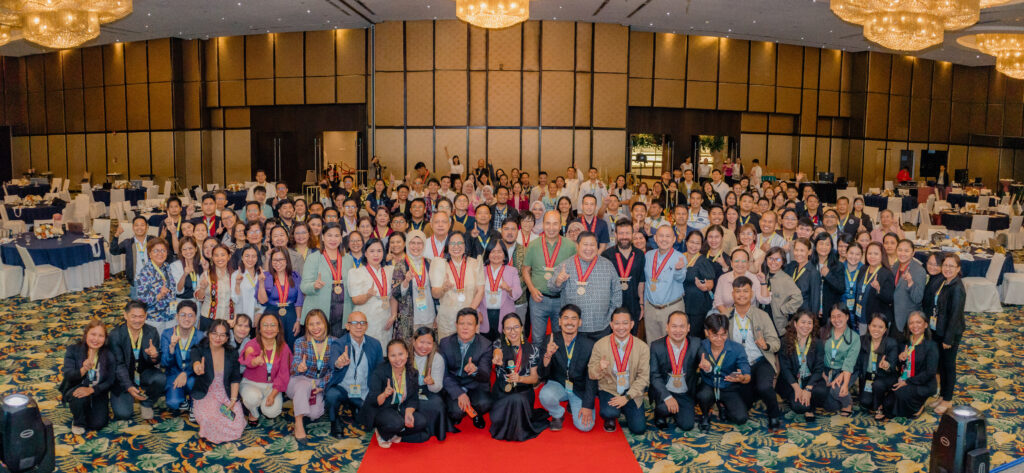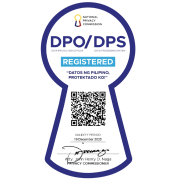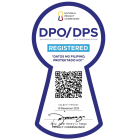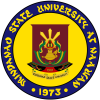MSUN illuminates pathways to collective excellence through SINAG 2025
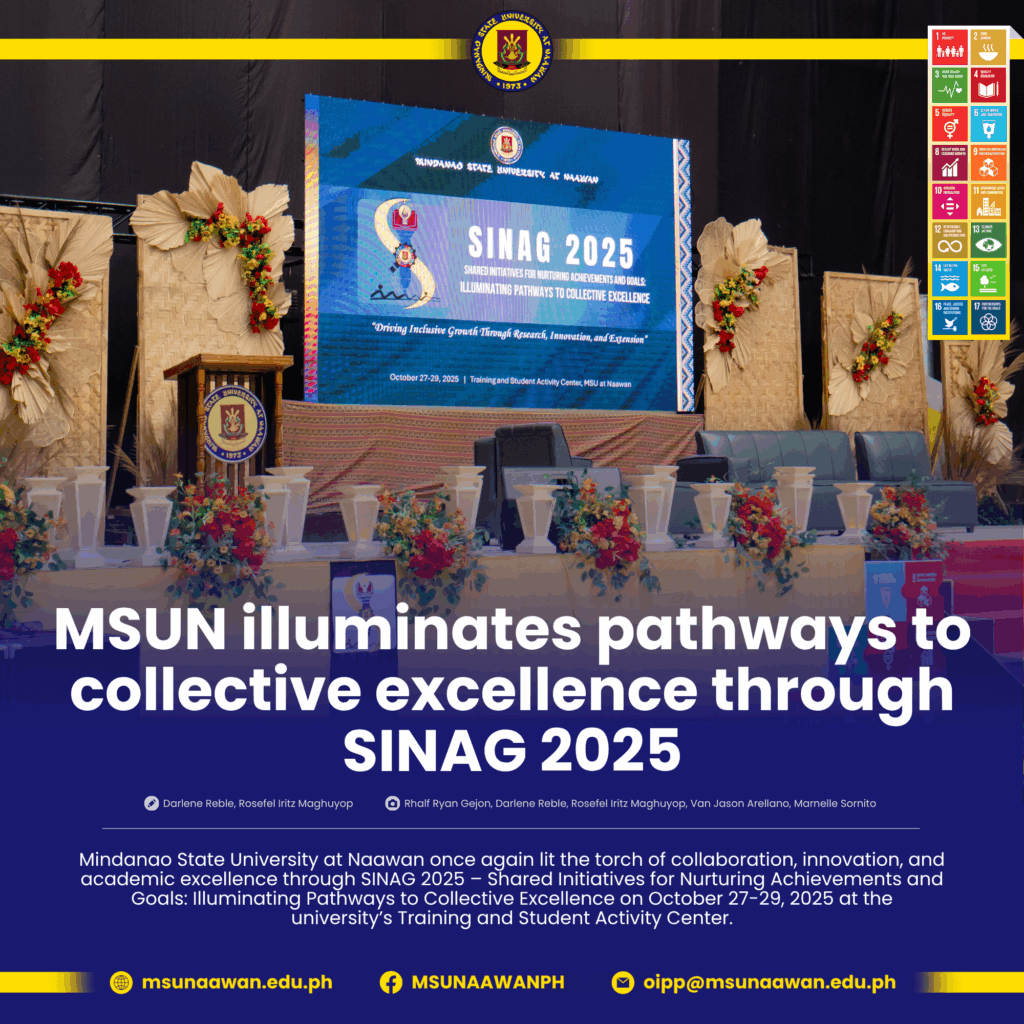
Mindanao State University at Naawan once again lit the torch of collaboration, innovation, and academic excellence through SINAG 2025 – Shared Initiatives for Nurturing Achievements and Goals: Illuminating Pathways to Collective Excellence on October 27-29, 2025 at the university’s Training and Student Activity Center.
Anchored on MSUN’s mission of providing transformative education, advancing research, and fostering sustainable community engagement, the three-day event was convened by faculty, researchers, students, and partner institutions to share insights and chart the course toward collective excellence.
“Ang SINAG dili lang usa ka tinuig nga kalihokan; it is a symbol of our unity as one academic community —the Mindanao State University at Naawan, built upon our shared vision to serve, to innovate, and to inspire. This year marks the birth of a new tradition — what we now call SINAG,” delivered MSUN Vice Chancellor for Research, Innovation, and Global Engagement Dr. Rey Y. Capangpangan on his opening message.
He added, “In the previous years, this gathering was known as the Agency In-House Review, but today, it takes on a new name and a deeper meaning. Thus, SINAG 2025 is born — a symbol of light, unity, and shared commitment to nurture achievements and goals that drive inclusive growth through research, innovation, and extension.”
As MSUN’s Agency Annual In-House Review, SINAG 2025 served as a dynamic platform for reflection, recognition, and strategic alignment of the university’s programs and initiatives, celebrating milestones in research, development, and extension.
At its core, SINAG 2025 embodies MSUN’s core values of being Mission-driven, Sustainable, United, and Nurturing, a reflection of its continuous pursuit of relevance and impact. Through plenary presentations, research colloquia, stakeholder forums, and exhibits, the event showcased the university’s role as a catalyst for innovation and inclusive growth in Mindanao and beyond.
𝙎𝙝𝙤𝙬𝙘𝙖𝙨𝙞𝙣𝙜 𝙄𝙣𝙣𝙤𝙫𝙖𝙩𝙞𝙤𝙣 𝙖𝙣𝙙 𝙎𝙘𝙝𝙤𝙡𝙖𝙧𝙡𝙮 𝙄𝙣𝙦𝙪𝙞𝙧𝙮
The inaugural day of SINAG 2025 commenced with a vibrant and forward-looking showcase of innovation through the official launch of research and extension e-posters and booth exhibits.
This dynamic display featured the groundbreaking work of Mindanao State University at Naawan’s various research centers, presented alongside key partner agencies like the Philippine Council for Agriculture, Aquatic and Natural Resources Research and Development of the Department of Science and Technology (DOST-PCAARRD)’s Regional Agri-Aqua Innovation System Enhancement (RAISE) program 10.
The exhibits served as a tangible representation of the university’s diverse and impactful research portfolio, highlighting critical advancements in environmental sustainability, innovative solutions for food security, and effective strategies for community empowerment.
As the day progressed, the focus shifted to a rigorous intellectual forum with the Colloquium for Theses and Dissertations. This pivotal session provided a platform for MSUN’s own faculty and staff to present their advanced academic research, sharing the depth of their scholarly pursuits with colleagues and the wider community.
More than just a series of presentations, the colloquium stood as a powerful testament to the institution’s unwavering commitment to fostering a robust culture of inquiry.
By championing the continuous professional development of its academic community, MSUN reaffirms its dedication to cultivating an environment where scholarly excellence and intellectual curiosity thrive.
𝘼𝙙𝙫𝙖𝙣𝙘𝙞𝙣𝙜 𝙁𝙧𝙤𝙣𝙩𝙞𝙚𝙧𝙨 𝙤𝙛 𝙎𝙘𝙞𝙚𝙣𝙘𝙚 𝙖𝙣𝙙 𝘾𝙤𝙡𝙡𝙖𝙗𝙤𝙧𝙖𝙩𝙞𝙫𝙚 𝙍𝙚𝙨𝙚𝙖𝙧𝙘𝙝
The second day featured a series of plenary talks from distinguished international and national scientists whose expertise provided valuable insights into emerging frontiers of science and innovation.
Dr. Fernando P. Siringan, Academician at the National Academy of Science and Technology and Research Professor at the UP Marine Science Institute, opened the plenary with a compelling lecture titled “Submarine Groundwater Discharge: Their Significance in Marine Ecosystems.” His talk shed light on the often-overlooked role of submarine groundwater discharge in shaping coastal water quality, nutrient dynamics, and marine biodiversity, offering critical insights for sustainable coastal management and marine conservation.
Dr. Meng Chuan Ong, Associate Professor at the Faculty of Science and Marine Environment, Universiti Malaysia Terengganu, followed with his presentation “Living Sensors: Investigating Pollution through Aquatic Organisms.” His study emphasized how aquatic organisms can act as natural indicators of environmental health, providing an innovative, nature-based approach to detecting and addressing pollution in aquatic ecosystems.
Concluding the plenary series, Dr. Chandan Hunsur Ravikumar, Assistant Professor at the Centre for Nano and Material Sciences, Jain (Deemed-to-be-University), India, delivered his talk “Smart Sensing for Smarter Farms.” He showcased the transformative potential of nanotechnology in developing intelligent sensing tools for precision agriculture, highlighting how data-driven innovations can lead to more sustainable and efficient farming systems.
The afternoon was dedicated to a dynamic series of parallel sessions. These sessions provided a valuable avenue for in-depth dialogue, allowing presenters to share completed studies with conclusive findings, discuss ongoing projects to receive formative peer feedback, and engage in one-on-one conversations through interactive poster presentations.
Moreover, this multifaceted format fostered a vibrant marketplace of ideas, encouraging robust knowledge exchange across various disciplines and allowing attendees to immerse themselves in topics most relevant to their expertise and interests.
Ultimately, these parallel presentations were crucial for building collaborative connections and refining scholarly work within the academic community.
𝙎𝙩𝙧𝙚𝙣𝙜𝙩𝙝𝙚𝙣𝙞𝙣𝙜 𝙎𝙮𝙣𝙚𝙧𝙜𝙮 𝙩𝙝𝙧𝙤𝙪𝙜𝙝 𝙎𝙩𝙖𝙠𝙚𝙝𝙤𝙡𝙙𝙚𝙧𝙨’ 𝙁𝙤𝙧𝙪𝙢
The final day of SINAG 2025 culminated in a powerful display of synergy between academia, government, and local communities, primarily through a landmark Stakeholders’ Forum.
The session was anchored by an inspiring plenary talk from Mr. Roberto “Ka Dodoy” Ballon Jr., a 2021 Ramon Magsaysay Awardee, titled “Abundance, Healthy, Clean, and Safe Environment: Coastal Community Cooperation and Conservation.”
By sharing his compelling, real-world story of successful grassroots conservation, he grounded the day’s discussions in tangible reality, setting a deeply inspirational tone for everyone present. His journey served as a powerful testament to the idea that community-led initiatives are not just a possibility, but a potent force for creating remarkable environmental and social impact.
This provided the assembled academics and government officials with a living, breathing model of success, illustrating how policies and research can translate into meaningful action and demonstrating that true, sustainable change often begins with the passion and cooperation of the community itself.
Following his address, high-level representatives from key regional government agencies, including DOST, DICT, DSWD, BFAR, DENR, DOST-PTRI, NOMCARRD, DTI, and DAR, took the stage.
Each representative highlighted their respective agency’s major accomplishments and flagship programs, explicitly outlining partnership opportunities. They showcased initiatives designed to support the academe through research collaborations and funding, while also presenting community-based projects aimed at direct public engagement and development, effectively bridging the gap between policy, science, and community action.
The second Stakeholders’ Forum, gathered leaders from Local Universities and Colleges (LUCs) and MSUN to exchange best practices and strengthen inter-institutional cooperation.
The session was strategically anchored by a plenary presentation from CHED Region 10 Director Dr. Arlita Amapola B. Minguez, titled “CHED to A.C.H.I.E.V.E by 2030.” Her address was pivotal, providing a clear, high-level strategic roadmap from the region’s governing body that set a unified tone for higher education transformation and anchored the subsequent discussions in a shared long-term vision.
This strategic context elevated the succeeding presentations, transforming them into a dynamic and collaborative workshop.
Representatives from the City College of Cagayan de Oro, City College of El Salvador, Initao College, and MSU at Naawan went beyond simply sharing success stories.
They engaged in a candid exchange of institutional best practices, overview of their achievements in promoting innovation and inclusivity, and transparently identified their areas for improvement, with a particular focus on strengthening their research capabilities.
This open dialogue turned their individual experiences into practical, real-world examples of the “A.C.H.I.E.V.E” agenda in action, naturally paving the way for substantive discussions on future collaborations to foster mutual growth and advance the region’s academic landscape.
One highlight of the Stakeholders forum was the symbolic signing of partnerships and reaffirmation of commitments between MSU at Naawan and its key institutional collaborators.
This segment gives significance to the university’s proactive approach to sustaining and expanding its research and extension networks.
Representatives from partner agencies and academic institutions came together to formalize future collaborative engagements focused on advancing scientific innovation, environmental sustainability, and community development.
𝘾𝙚𝙡𝙚𝙗𝙧𝙖𝙩𝙞𝙣𝙜 𝘼𝙘𝙝𝙞𝙚𝙫𝙚𝙢𝙚𝙣𝙩𝙨 𝙖𝙣𝙙 𝙋𝙖𝙫𝙞𝙣𝙜 𝙩𝙝𝙚 𝙒𝙖𝙮 𝙁𝙤𝙧𝙬𝙖𝙧𝙙
The afternoon then transitioned into a celebration of tangible progress with the formal Turn-over and Acceptance of Completed Projects. This significant ceremony marked the concrete fulfillment of the university’s strategic vision for a smarter, more capable campus, showcasing a direct investment in academic excellence.
This commitment was embodied by two key achievements. The first was the “Smart Education Through Digitalization” initiative, led by Atty. Rommel Lloyd Martinez, President of Infobytes Solutions, Inc. The second was a major milestone in campus development with the formal acceptance of two new state-of-the-art facilities, the College of Environment and Life Sciences Building and the College of Fisheries and Marine Sciences Building.
These crucial infrastructure projects, providing modern spaces for learning and research, were successfully constructed by the Joint Venture of J.M. Luciano Construction, Inc. and VNP Construction and Design, represented by its Project Manager, Engr. Jose Q. Orcullo, Jr.
Moving on to the awarding ceremony, SINAG 2025 honored the top presenters and researchers through the awarding of winners from the colloquium, parallel oral sessions, poster presentations, and exhibits. This segment stood as a fitting tribute to the creativity, dedication, and intellectual rigor demonstrated by members of the MSU at Naawan academic community recognizing and celebrating outstanding scholarly contributions.
Each award conferred not only symbolized academic excellence but also represented the culmination of months, if not years, of hard work, perseverance, and commitment to advancing knowledge that responds to real-world challenges.
Subsequently, the focus shifted toward future endeavors with the official launch of several pivotal institutional initiatives. These included the unveiling of PANIKA, the establishment of the Online JEAR Portal, and the release of new scholarly publications such as books, conference proceedings, manuals, and other newly copyrighted IEC materials. This launch prominently highlighted the significance of MSUN’s intellectual property rights. Each of these outputs solidifies Mindanao State University at Naawan’s growing contributions to the academic community through dedicated knowledge creation and intellectual property development.
Culminating the three-day celebration was a cultural performance by the Indak Kalaunan Performing Arts and a musical serenade by the Koro Kaayad Kaligaon, symbolizing unity and pride in MSUN’s vibrant culture and achievements.
Wrapping up the event was MSUN Chancellor Dr. Elnor C. Roa, who extended her gratitude to the organizing committees, MSUN officials, guests, and speakers, and expressed her hope that the gathering would leave a lasting impact on the university community.
“As the Chancellor of MSU at Naawan, I am hoping that this gathering, rooted in our theme “Driving Inclusive Growth through Research, Innovation, and Extension,” may have been more than just an event — I hope it has served as catalyst for change, a beacon of hope, and a testament to what we can achieve when united in purpose,” said Dr. Roa.
More than a review, SINAG 2025 stood as a celebration of shared milestones and a blueprint for future aspirations. It illuminated pathways for strengthening MSUN’s research culture, nurturing partnerships, and inspiring every member of the university community to strive for excellence, sustainability, and service to society.

